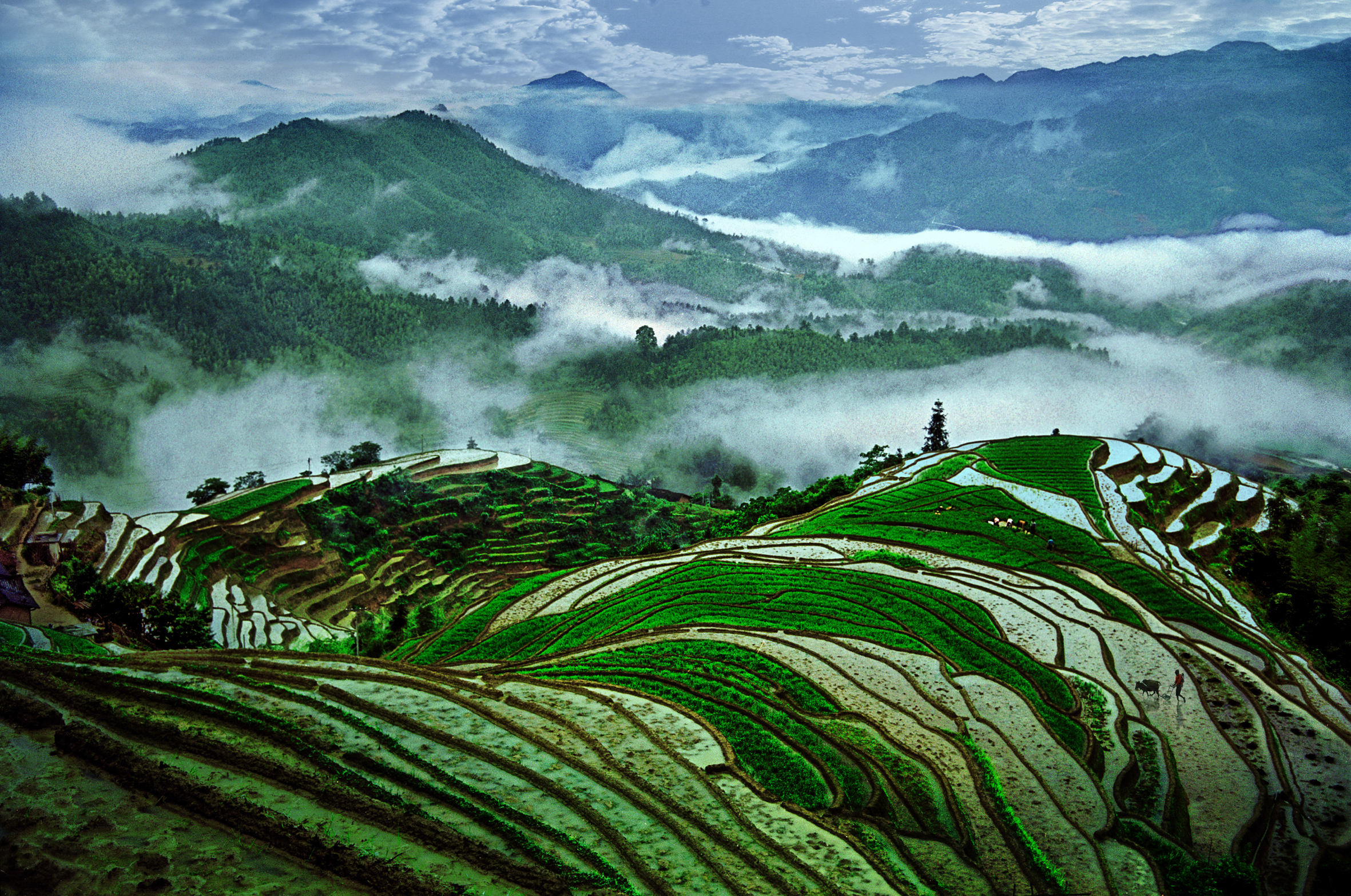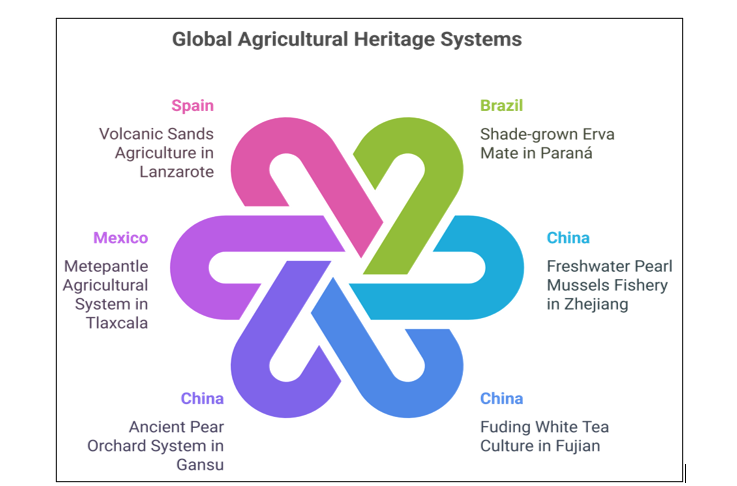- Courses
- GS Full Course 1 Year
- GS Full Course 2 Year
- GS Full Course 3 Year
- GS Full Course Till Selection
- Online Program
- GS Recorded Course
- NCERT (Recorded 500+ Hours)
- Polity Recorded Course
- Geography Recorded Course
- Economy Recorded Course
- AMAC Recorded Course
- Modern India, Post Independence & World History
- Environment Recoded Course
- Governance Recoded Course
- Science & Tech. Recoded Course
- International Relations and Internal Security Recorded Course
- Disaster Management Module Course
- Ethics Recoded Course
- Essay Recoded Course
- Current Affairs Recoded Course
- CSAT
- 5 LAYERED ARJUNA Mentorship
- Public Administration Optional
- ABOUT US
- OUR TOPPERS
- TEST SERIES
- FREE STUDY MATERIAL
- VIDEOS
- CONTACT US
Globally Important Agricultural Heritage Systems (GIAHS)
Globally Important Agricultural Heritage Systems (GIAHS)
26-05-2025

What Happened?
- Recently, The United Nations Food and Agriculture Organization (FAO) added six new places to its list of Globally Important Agricultural Heritage Systems (GIAHS).
- These places show how traditional farming methods passed down through generations.
- These methods are helping people grow food, protect the environment, and support local cultures and jobs even in the face of climate change and biodiversity loss.
- There are now 95 special farming systems in 28 countries recognized by FAO for their unique and sustainable agricultural practices.
What is GIAHS?
- The Globally Important Agricultural Heritage Systems (GIAHS) are special farming areas that have been protected by people for a long time.
- These places are lived in by communities who have a close connection with their land.
- These farming systems keep changing and staying strong over time.
- They have many different plants and animals, old farming knowledge, rich cultures, and beautiful landscapes.
- Farmers, herders, fishers, and forest people take care of these systems in ways that help them earn a living and have enough food.
- The Food and Agriculture Organization of the United Nations has officially recognized 95 of these special farming systems in 28 countries through the GIAHS program.
What are these New Six GIAHS?

- Erva-Mate Agroforestry System, Parana, Brazil:
- Indigenous people and local communities in southern Brazil have been growing a plant called erva-mate for hundreds of years .
- They grow it in the shade of trees, using old, traditional farming methods that are friendly to nature.
- The leaves of the erva-mate plant are used to make popular drinks like chimarrao, terere or mate in countries like Argentina, Uruguay and Paraguay.
- Farmers also grow food crops, native fruits, and collect useful things from the forest.
- This helps protect many kinds of plants and animals, supports local food, and keeps their culture strong.
- This system also helps save the Araucaria Forest, which is one of the most endangered forests in the world.
- Today, only 1% of the original forest is left because of deforestation. This way of farming is special because it protects the forest while giving people food, income, and a way to keep their traditions alive.
- Deqing Pearl Mussels and Fish Farming, Zhejiang, China:
- In Deqing County, China, farmers have been using a special farming method for 800 years.
- They raise fish and pearl mussels together in the same water.
- This method also includes growing crops like rice and making things like silk.
- This system gives many useful products such as pearls, rice, silk, and more.
- It also protects nature, helps people get enough food, and keeps local traditions alive.
- The mussels help clean the water. They reduce harmful things like ammonia, nitrite, and nitrogen, and make the water healthier for fish and plants.
- More than 22,000 people earn their living by growing food, making pearls, guiding tourists, and teaching others about this traditional farming method.
- This old and smart farming system shows how people can grow food and take care of nature at the same time.
- Fuding White Tea Farming, Fujian, China:
- In Fuding, China, people have been growing white tea for hundreds of years using traditional and eco-friendly methods.
- They grow tea along with forests and other crops, which helps protect nature and supports the lives of local farmers.
- This tea cultivation system is based on the Luxueya Mother Tree and uses natural ways to dry the tea leaves.
- It is also an important part of the local culture, with strong ties to people’s daily life and traditions.
- The system saves 18 types of tea trees and also includes over 120 other kinds of plants and animals like vegetables, fruits, animals, fish, and mushrooms. This mix helps keep the environment healthy and makes the food system strong.
- Ancient Pear Orchard, Gansu, China:
- In Shichuan town near the Yellow River in China, farmers have been using a special farming system for 600 years.
- They grow tall pear trees using an old method called “Gaotian.”
- Along with pears, they also grow other crops and raise animals on the same land.
- This system helps keep old types of pears like Ruan’er and Dongguo alive.
- It can survive both dry weather and floods, and it supports farmers by giving them food and income.
- Every year, they grow over 2 million kilograms of pears. These are sold as fresh fruit, dried pears, or made into local food items.
- This area is very dry and the soil is easy to wash away, but the farming method works well even in these tough conditions.
- It also protects local plants and insects because farmers grow many different crops together and use fewer chemicals.
- Metepantle System, Tlaxcala, Mexico:
- Farming families have been using a special farming method called the Metepantle system for over 3,000 years in the dry and hilly areas of Tlaxcala, Mexico.
- They grow crops like maize (corn), agave, beans, squash, and wild plants on terraced land (steps built into hills).
- This system comes from the knowledge of the Nahua Indigenous people.
- It helps protect seeds, supports plants and animals that live in dry areas, and gives people food and income.
- It also keeps their culture and traditions alive in one of the areas most affected by climate change in Mexico.
- Farmers grow and protect over 140 native plant species, including 40 types of maize and 30 types of edible greens.
- They share and save seeds through family customs, seed fairs, and local exchanges.
- This system gives people many useful things like food, drink, fibres (for clothes and tools), stronger soil, and homes for bees and other helpful insects.
- Volcanic Farming, Lanzarote Island, Spain:
- Lanzarote is one of the Canary Islands.
- It has dry land with black volcanic soil that looks like the surface of the moon. The wind blows strongly most of the time.
- In the 1700s, after six years of volcanic eruptions, farmers found a smart way to grow crops in this difficult land. They used small pieces of volcanic rock (called lapilli) and sea sand (called jable) to cover the soil.
- This method helps keep water in the ground, keeps the soil cool, and protects the crops from heat and wind.
- Using this method, farmers grow grapes, sweet potatoes, and beans. They do this with very little water.
- This farming method is called the enarenado system.
- It covers more than 12,000 hectares of land.
- It mixes volcanic ash and sea sand that the wind brought over many years.
- This system helps farmers grow food, protect nature, and keep their traditions alive in one of the driest parts of Europe.
How Many GIAHS Sites are Present in India?
- Pampore Saffron Heritage, Jammu & Kashmir (2011):
- Pampore, in the Kashmir region, is famous for growing saffron, a special and costly spice. It grows on dry, raised lands called Karewas.
- Saffron is a big part of Kashmiri food, traditional medicine, and culture.
- Along with saffron, people also grow rice as the main food crop.
- Other crops like maize, millets, pulses, wheat, and barley are also grown.
- The region also grows many fruits such as apples, almonds, cherries, peaches, pears, and walnuts.
- Koraput Traditional Farming System, Odisha (2012):
- Koraput is a hilly region in the Eastern Ghats of Odisha.
- Most of the land here is used to grow rice for daily needs.
- This kind of farming is called subsistence farming where farmers grow food mainly for their own families.
- The area is also home to many useful plants, especially medicinal plants.
- The traditional farming system in Koraput is closely connected with the tribal people who live here.
- There are about 52 tribal groups, including the Khond, Bhatada, Paroja, Bhumia, and Bonda tribes.
- These communities follow old farming methods and have a deep respect for nature.
- They also take care of sacred groves, small forest areas they protect because they believe they are holy.
- These groves help save many rare plants.
- Kuttanad Below Sea Level Farming System, Kerala (2013):
- Kuttanad in Kerala is a special place where people grow rice below sea level.
- It is the only place in India where this happens.
- Long ago, Farmers drained swampy areas near the sea to make land for farming. Even today, they grow rice in this low-lying land.
- The area has different types of land:
- Wetlands used for growing paddy (rice) and fishing.
- Garden lands where people grow coconut, tubers (like yam), and other food crops.
- Water bodies where inland fishing takes place.
What is the Significance of GIAHS?
- Protect Traditional Knowledge: These systems keep farming methods alive and passed down through generations, preserving valuable wisdom.
- Support Food Security: They help communities grow enough food sustainably, even under changing climatic conditions.
- Conserve Biodiversity: The systems maintain many types of plants, animals, and ecosystems, helping protect nature.
- Adapt to Climate Change: Their farming methods are resilient, helping people cope with droughts, floods, and other climate challenges.
- Preserve Culture and Heritage: These systems keep alive local traditions, cultures, and ways of life connected to the land.
- Provide Livelihoods: They offer jobs and income for local people through farming, tourism, craft-making, and more.
- Protect Environment and Soil: Sustainable practices help keep soil healthy and reduce environmental damage.
- Showcase Sustainable Farming: These systems are examples of how ancient farming wisdom can address today’s problems and guide a sustainable future.
What are the Challenges Associated with Traditional Farming Systems?
- Loss of Traditional Knowledge: As younger generations migrate to urban areas for education or jobs, fewer people stay behind to learn and carry forward traditional farming methods.
- Low Economic Returns: Traditional farmers often grow diverse crops using eco-friendly methods, but they may not earn as much as large-scale commercial farmers. Limited profitability can discourage youth and lead to the abandonment of these systems.
- Poor Infrastructure and Market Access: Many traditional farming areas lack roads, storage, processing units, or access to markets. Farmers may face difficulties in transporting or selling their produce, limiting income opportunities.
- Declining Agrobiodiversity: Market-driven agriculture and monoculture practices can push farmers to abandon traditional crops and local varieties. This reduces the genetic diversity that supports climate resilience and food security.
- Weak Policy and Institutional Support: Governments often focus more on modern agricultural technologies. Traditional systems receive little attention in terms of subsidies, research, education, or protection.
- Land Pressure and Urbanization: Expanding cities and infrastructure projects often encroach on traditional farmlands. This reduces the land available for traditional farming.
Way forward
- Policy Support and Recognition: Governments should officially recognize traditional farming systems as important for food security, biodiversity, and climate resilience. They must include these systems in agricultural, environmental, and cultural policies.
- Financial Incentives and Subsidies: Provide targeted subsidies, crop insurance, and low-interest loans to farmers practising traditional agriculture. Financial support will help improve livelihoods and encourage the next generation to continue these practices.
- Better Market Access: Help farmers to reach bigger and fairer markets by setting up storage facilities, cold chains, local processing units, and farmer-producer organisations. Promoting local and organic branding can fetch better prices.
- Scientific Research and Innovation: Support research to blend traditional practices with modern science. Simple innovations like organic pest control, water-saving methods, and improved seed banks can boost productivity without harming the environment.
- Youth Engagement: Involve young people through skill development, entrepreneurship support, and digital tools. Highlighting the economic and cultural value of these systems can make traditional farming more attractive to the youth.
- Global Platforms and Recognition: Use international initiatives like GIAHS (Globally Important Agricultural Heritage Systems) to promote traditional farming at the global level. This also opens up opportunities in eco-tourism and cultural exchange.
|
Also Read |
|
| FREE NIOS Books | |



